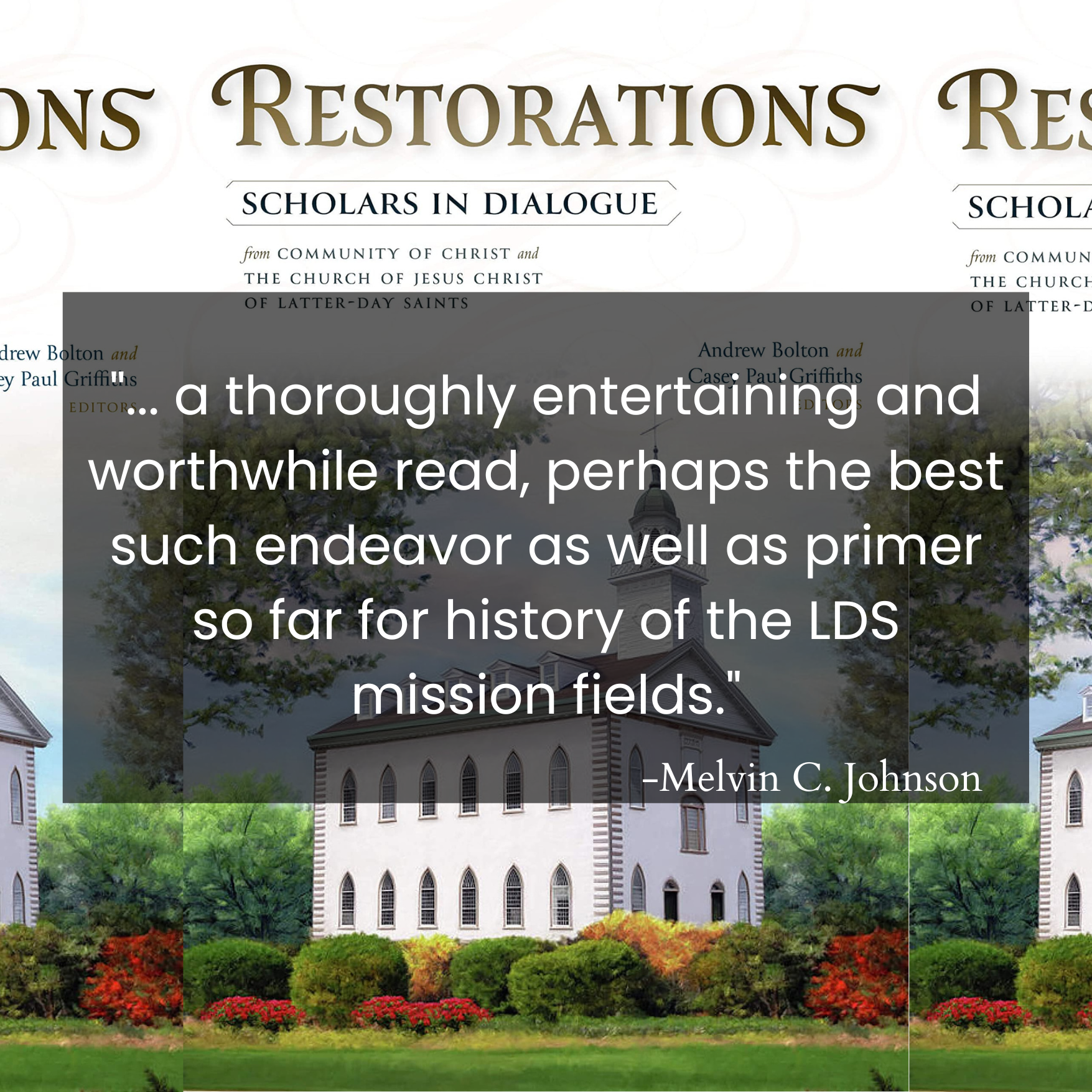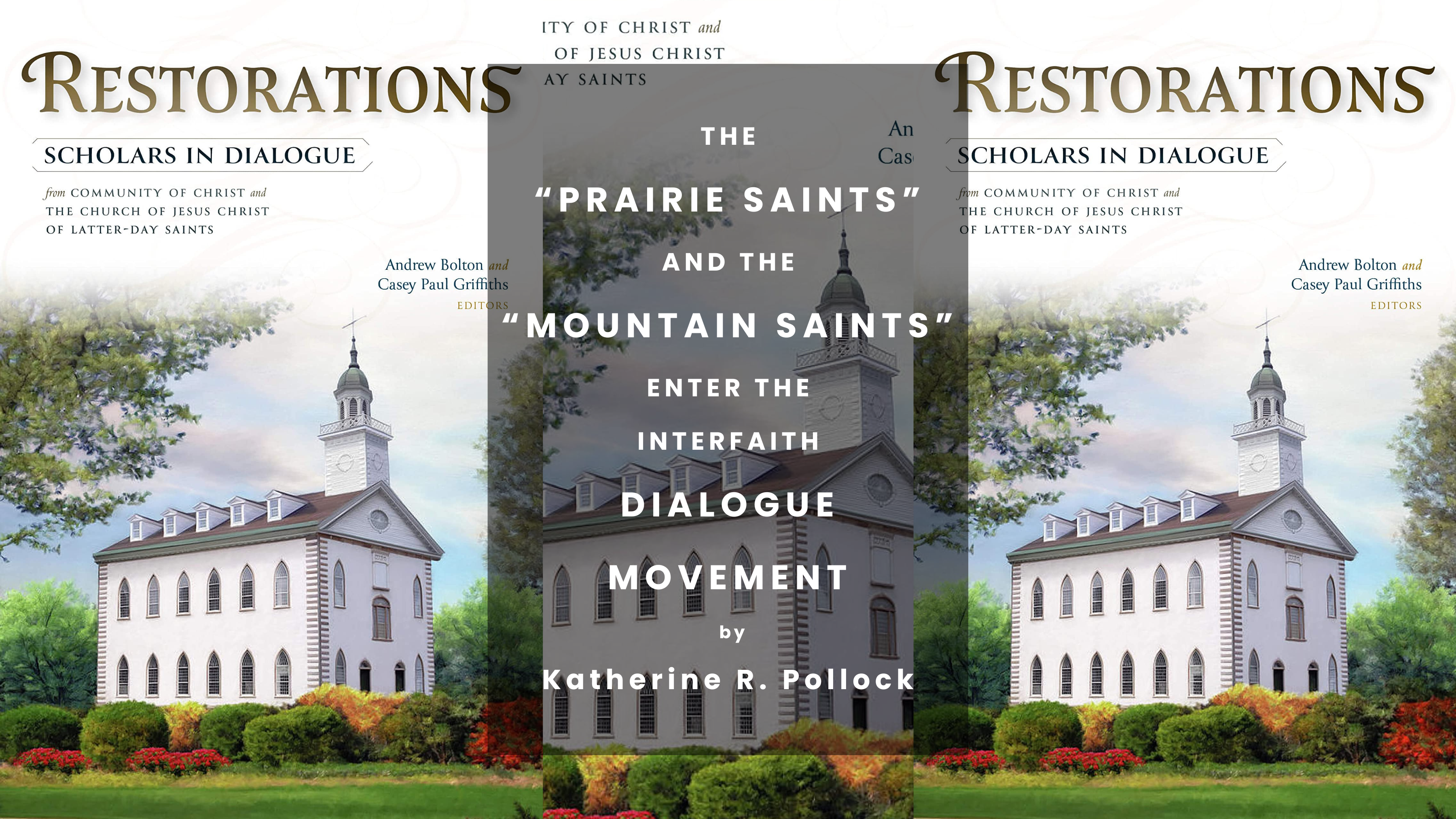Articles/Essays – Volume 57, No. 1
The “Prairie Saints” and the “Mountain Saints” Enter the Interfaith Dialogue Movement | Andrew Bolton and Casey Paul Griffiths, eds. Restorations: Scholars in Dialogue from Community of Christ and the Church of Jesus Christ of Latter-day Saints.
The Restoration’s “oldest enemies” have finally come together in their first collaborative publication to examine the similarities and differences between the Missouri-based Community of Christ (formerly the Reorganized Church of Jesus Christ of Latter Day Saints) and the Utah-based Church of Jesus Christ of Latter-day Saints. Restorations: Scholars in Dialogue is a series of ten interfaith dialogues that cover such topics as Jesus Christ, Scripture, Salvation, Ordinances and Sacraments, Prophets and Polity, Personhood, The First Vision and Continuing Revelation, Apostasy and Restoration, Shared Sacred Space, and Zion.
Edited by retired Community of Christ Apostle Andrew Bolton and BYU professor Casey Paul Griffiths, each essay is aimed toward a general audience with some background in the Restoration. The volume is considered an interfaith dialogue, rather than ecumenical dialogue, because of a lack of a shared ecclesiastical understanding. The compilation is the fruition of the Latter-day Saint/Community of Christ scholars dialogue group developed at BYU in 2016. The goal of each chapter was for a scholar from each tradition to author an essay overviewing how their topic is currently understood, thoughtfully reply to the other’s essay, and offer a combined short conclusion. Most essayists also explained the historical development of the topic.
There are notable tensions in some of the exchanges between the dialogists. However, readers should see this as a natural part of genuine exchange rather than a source of discomfort. A prime example is the dialogue on Personhood with BYU professor Barbara Morgan Gardner and Community of Christ member Christie Skoorsmith. While the dialogists agree that people from all backgrounds are of infinite worth to God, disagreement about the implications turns into a debate about women’s ordination, gender, sexuality, and whether truth about these subjects is eternal or changeable.
Along with the tension are many moments of genuine appreciation between traditions. David Howlett (Zion) says he has admiration for the ways Latter-day Saints use the idea of Zion to help people in need using the nineteenth-century Perpetual Emigrating Fund and the contemporary Perpetual Education Fund as examples. Casey Paul Griffiths (Sacraments and Ordinances) admires Community of Christ’s strong spirit of inclusiveness in administering their sacraments, citing the Community of Christ’s use of the internet to offer sacraments at a distance.
The chapter on Apostasy and Restoration shows a different dynamic than the rest of the volume. Gina Colvin, a Latter-day Saint convert to Community of Christ, critiques the current Latter-day Saint perspective, as well as explains the Community of Christ view in an essay wrapped in her faith journey. Her dialogue partner, Jordan T. Watkins, replies that her understandings of both traditions are based more on her personal faith journey than researching the full historical development of the topic. The dialogue might have been improved by the editors providing concrete guidelines for dialogue. Her insider critique may appear as an attack on Latter-day Saint readers. Watkins’s reply also shows that the two dialogists were not on the same page about the interaction.

Each chapter can only be considered an introduction; however, I wish contributors had pursued the following insightful topics into their chapters: the reasons that Latter-day Saints do not ordain women and more details about where they can serve in their church without having the priesthood; the differences between the Latter-day Saint patriarchal blessing and Community of Christ’s evangelist blessing; education of members and the training of top leaders in both churches and how that relates to scripture. What it means to be a prophet and how prophets are treated by members in both churches.
The book ends with an afterword that includes a review of how the dialogue changed and challenged the participants. Both editors note that this book is not an end but a starting point with many more topics to discuss and people to include in the dialogue. This volume is also an example of how publishers in Mormon studies need to include women in the conversation. Only two out of the eleven Latter-day Saint contributors are women, likely the result of pooling participants from Brigham Young University’s College of Religious Education. Only the Community of Christ side included international members. A future dialogue between international members from both traditions would be significant for the field.
The editors of and contributors to this volume should be proud of this important contribution. Since the 1980s, books dedicated to comparing the beliefs and practices of the two traditions have been single-authored publications that synthesized Church leader statements and official documents with some history. Other unique textbooks, like Mormonism: The Basics (Routledge, 2016) described multiple Mormonisms as examples of broader trends of American religion. Using the format of interfaith dialogue, this collaboration brings something new by letting members of both movements themselves describe the nuanced beliefs and lived religion of their churches and bring those experiences into conversation. Such descriptions are harder to find in print for Community of Christ. Church members who are serious about encouraging good relations within the Restoration and scholars who want to expand their understanding of the traditions should read Restorations: Scholars in Dialogue.
Andrew Bolton and Casey Paul Griffiths, eds. Restorations: Scholars in Dialogue from Community of Christ and the Church of Jesus Christ of Latter-day Saints. Provo: BYU Religious Studies Center; Salt Lake City: Deseret Book; Independence: John Whitmer Books, 2022. xxii + 231 pp. Paper: $18.99. Ebook: $18.99. ISBN: 9781950304318.


 Back to full Issue
Back to full Issue

